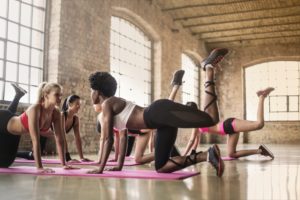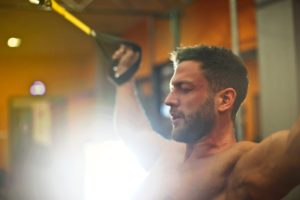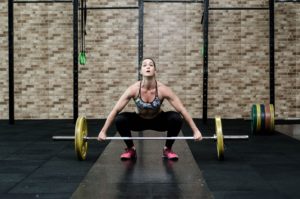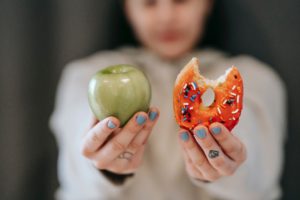Sign Up For Special Offers & Exclusive Content
The Impacts Of Exercise On A Sedentary Lifestyle
Most professionals working in office settings are familiar with the health impacts of a sedentary lifestyle. Extended periods spent behind a desk can lead to various health issues, even if you engage in regular exercise. Sadly, the common misconception that a few hours at the gym can fully counteract a week of inactivity is not entirely accurate. This article aims to expand on the problem, and present more appropriate, lifestyle-based solutions.
The Consequences Of Being Sedentary
Those working desk jobs often face discomforts such as neck, shoulder, and back pain, along with feelings of lethargy and digestive problems. Over a more extended period, the risks become even more significant. A 13-year study from the American Journal of Epidemiology revealed that individuals who were sedentary for more than 6 hours a day had a 94% higher likelihood of mortality than those who sat for less than 3 hours daily.
Negative Health Impacts of a Sedentary Lifestyle:
- Increased Risk of Chronic Diseases: A sedentary lifestyle has been linked to a higher risk of developing diseases like type 2 diabetes, certain types of cancer, and heart disease.
- Weight Gain: Physical inactivity can result in weight gain and increase the risk of obesity.
- Muscle Degeneration: Without regular use, muscles can weaken and atrophy.
- Bone Loss: A lack of activity can lead to decreased bone density and an increased risk of osteoporosis.
- Reduced Metabolic Health: This can include issues like elevated blood pressure, high blood sugar, excess body fat, and abnormal cholesterol levels.
- Mental Health Challenges: Sedentary behavior can exacerbate feelings of anxiety, depression, and lower mood levels.
- Decreased Circulation: Sitting for extended periods can cause blood to pool, leading to varicose veins or deep vein thrombosis (DVT).
- Poor Posture: Continuous sitting, especially with improper ergonomics, can lead to postural issues that cause neck and back pain.
- Reduced Cognitive Function: Physical inactivity may be associated with cognitive decline in the long term.
- Compromised Respiratory Health: Prolonged sitting can lead to shallow breathing and reduced lung capacity.
- Digestive Issues: Physical inactivity can contribute to constipation and other digestive disorders.
Exercise: A Partial Solution To A Sedentary Lifestyle?
Incorporating regular movement into daily routines is crucial to mitigate these risks. Even short breaks, stretching, or walking can have significant positive impacts on overall health.
While regular exercise is beneficial, relying solely on a few hours of weekly gym sessions is not sufficient. Contrary to the belief that exercise alone can negate an otherwise sedentary lifestyle, spending 2-3 hours exercising amidst a 168-hour week won't compensate for 40+ hours of inactivity.
Consider four distinct lifestyle categories:
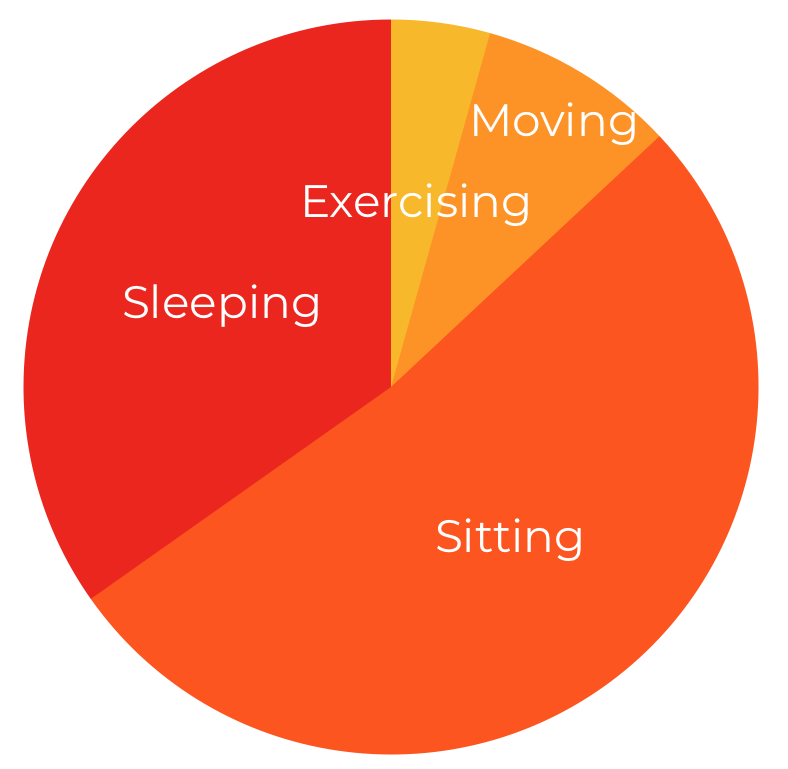
One hour of exercise has very little effect on overall daily energy expenditure

Simon
Sedentary Inactive

Savita
Sedentary Active

Miriam
Mobile Inactive

Malik
Mobile Active
Definition of key terms:
Sedentary
Sitting for most of the day
Mobile
Moving for most of the day
Active
Exercises regularly
Inactive
Does not exercise regularly
Simon
Sedentary Inactive

Displays minimal movement throughout the day, representing a large segment of the western population. Such a lifestyle leads to elevated risks, including obesity, cardiovascular disease, and difficulties in regulating blood sugar and pressure.
Savita
Sedentary Active

Although she integrates a lunchtime exercise class into her routine, Savita's overall activity level doesn't vary significantly from Simon's, and so the health advantages are limited. Whilst the burst of extra activity has a positive impact, her lifestyle is still mostly sedentary.
Miriam
Mobile Inactive

Miriam has a job that necessitates constant movement. Despite not participating in formal exercise, her daily activity is considerably higher than both Simon and Savita's, leading to improved health outcomes.
Malik
Mobile Active

Malik engages in both regular movement and exercise, providing him the best health prospects of the group. Whilst general activity is the best protection against the health impacts of a sedentary lifestyle, the addition of focused exercise helps him to build strength, fitness and flexibility, achieving an even greater level of wellbeing.
Differentiating Between Movement and Exercise
Exercise is undeniably essential for physical and mental health. When done properly, it strengthens your muscles and bones to prevent ageing, and improves cardiovascular and nervous system function for fitness and cognitive function. However, the differentiation between "exercise" and "movement" is crucial. To illustrate, Miriam, who doesn't engage in formal workouts, may still enjoy better health than Savita, who exercises but remains largely sedentary. The aforementioned study highlights the significant risks associated with prolonged sitting, regardless of exercise.

Just being a little more active when you might normally be sedentary has a big impact on your overall daily energy expenditure
Human evolution over the past 10,000 years hasn't drastically changed our physiological needs. Agriculture and technology have completely changed the way we live, including how well and how much we move. These modern-day conveniences contrast sharply with the lifestyle of our hunter-gatherer ancestors, who were consistently mobile. By way of evolution, human bodies are made for roaming, running, climbing, traversing, and tackling obscure obstacles. Our ancestors spent their time seated on uneven ground, playing, swimming, fighting and hunting. Whilst adopting exercises like weightlifting or yoga is beneficial, integrating regular movement throughout the day is paramount for optimal health.
Implications for Today's Professionals
The "use it or lose it" principle is especially relevant here. Persistent sedentary habits can lead to muscle atrophy, joint pain, and a decline in basic physical abilities.
Recognising that exercise is not a complete solution for a sedentary lifestyle is essential. Addressing the challenges of a sedentary life requires a comprehensive approach: one that encompasses consistent movement, mental well-being, and a personalised strategy tailored to individual lifestyles and constraints.
Leading a sedentary lifestyle has real consequences. Stick to it for too long, and you'll find yourself ageing faster, facing a slew of health problems, and potentially cutting years off your life. It's a tough reality to swallow, but recognising this gives us a chance to change how we approach our health and our day-to-day routines.
Now, you might be thinking, "I have a demanding job, and a pile of responsibilities. How can I possibly make time to move more?" I completely understand your dilemma.
I started my career in personal training, working with clients to enhance their physical fitness. Over time, I realised that many of the professionals I trained were dealing with more than just physical challenges. They were stressed, often overwhelmed, and struggling to find a balance. It was clear that they needed more than just a fitness and nutrition routine.
This understanding led me to become a wellbeing coach, and ultimately, to specialise in corporate wellbeing. I wanted to support these individuals holistically - not just physically, but mentally and emotionally as well.
Most of the people I work with are juggling intense professional lives. They come to me feeling run down, out of shape, and unsure of how to turn things around. What they need isn't just a workout plan. They need guidance on overall health, a plan that fits into their busy schedules, and someone who understands the challenges they're up against. That's where the Body Project comes in.
Search Posts
Free Download
Popular Posts
Discover Online PT
Read More Helpful Articles
Subscribe For New Post Updates
Receive new posts, special offers, discounts, plus exclusive content that we only send out via email.
Don't miss out!


